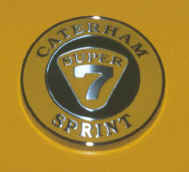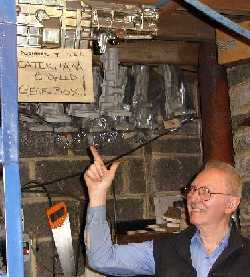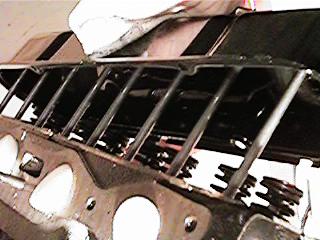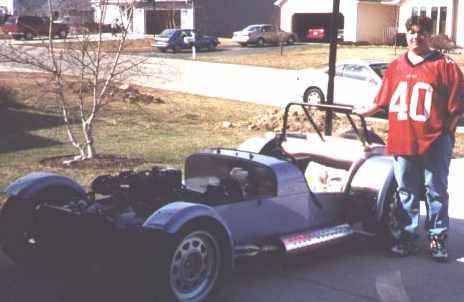
Main Page
What's a Seven?
Build page Pics
Driving
Zetec vs. X-Flow
Conversion to Zetec
Gearbox upgrade
Maintenance Log
7's 50th Anniversary
Gallery
Anecdotes
Registration
Books
Links
 |
For the pictures, go to: Build process Pictorial |
 |
After ordering the unassembled car in October of '98
from RMSCI
- Rocky Mountain Sports Cars inc. from Colorado via their Web
site
followed a long waiting period. Mostly anticipation. I had wanted one
since
I was 15, and having read only the occasional magazine article, this
was
going to be a significant event. In part because it is so rare, it is
often
categorized as a "kitcar". Note that a traditional kit, implies
"replica",
and the Caterham is not a replica, but rather the continuation of the
original
Lotus 7 series III. This has been confirmed by the actual
transfer of the rights
in '73 from Lotus founder Colin Chapman to Graham Nearn of Caterham,
who had been
building and selling the Lotus 7 for Lotus for many years up to that
date.
More significant is that the heritage is carried on by it's
construction details and philosophy - no two parts where one can do,
and to go fast "add lightness". Still today the chassis and suspension
construction
and concepts are a direct continuation of the original Seven.
More
important, Caterham has managed to evolve the design in a logical
manner
without compromising the original concepts. Chief engineer Jez Coates
at Caterham has had ownership for the technology evolution since the
early days.
Numerous copies and more or less successful derived versions have
followed,
confirming that the Seven is the answer for many when it comes to
exciting
motoring.
Not to underestimate: it is the concept
for true motoring that is copied
in the various incarnations of the Seven, which is at the root of all
the
derivatives. More impressive is that some of these derivatives are from
the
ground
up constructions, requiring significant skill from their builders. This
need for adventure during the construction process epitomizes the Seven
Spirit more than anything and takes it beyond badges!
For my car, engine and transmission were ordered separately from the "kit" via RMSCI (now an extension of Caterham USA) , a traditional 1600cc Kent Ford Crossflow with double 40 mm DCOE Webers and a 5 speed Sierra Type 9 gearbox. Shipped from the UK erroneously to Colorado, they had to be shipped back to Wisconsin. When it arrived it looked ok, but I did not bother to check under the valvecover - an oversight I would not realize until several weeks later..
Wisconsin winters are long and cold, about -10..20C for weeks during Jan & Feb. I managed to make a factory visit to Dartford (UK) mid January of '99 , hoping to see my (unassembled) car before it got shipped out, but the schedule was ahead of plan and the car had already been moved to the packers. No matter, seeing the Dartford factory was a significant event for me, never having seen a Caterham or Lotus 7 other than in pictures. I arrived by cab and with my imagination running wild, I expected something analogous to a Bee-hive with many 7's in traffic as I was approaching "the source". Turning onto "Caterham Street" clearly showed a field of Sevens around the shop and an appropriately marked Caterham truck - this certainly helped satisfy the anticipated imagery. The cabby did not know about Caterham Cars - unreasonable on my part perhaps, yet I felt all Brits should be aware of their remaining car brands and take pride in it. Of course very very few people in the US know of Caterham, a few more but not many of Lotus.
I was offered my first ever Seven ride by Len Unwin, a
nervous
but ever smiling fellow who took me out in a dark metallic blue "de
Dion
Wide Track" (like mine) with a Rover 1.8 VVC (153 BHP) 6 speed.
Anticipation
was tremendous. I worried about actually fitting in the car, since even
though only 5'8", living in Wisconsin (USA) and middle age has allowed
me to
display some wealth if you will. Size 10.5/43 shoes was a concern as
well.
And then... would it really be fast. I used to drive a Honda /
Acura
Integra, 1.8 ltr / 142 BHP which I liked to think of as a quick
car.
I fitted no problem, in spite of the winter coat. Passenger
side
- some mishap caused them to no longer let people "test drive" these
cars
- a good idea, as it could be lethal with an uncoordinated
driver.
Warming the car up we made our way towards some multi- lane road with
roundabouts.
Len pointed to the temperature gauge, making sure it was warming up.
The car was surprisingly quiet with the side screens up, not bad.
Acceleration
so far was ok, but not like my Integra, I was getting concerned..
.
. "Ok, it's warm I think" Len spooled it up to 4000 rpm and dropped the
hammer - YES!!. Not having been in a Seven before I was not prepared
for
this. Next roundabout, we slow down to about 60 mph and do not bother
to
yield - "they can't react that quick - it's ok..." slight oversteer,
but
the cornering forces were quite tremendous. I no longer had
anything
to compare.
The 6 speed gearbox, originally designed by Brian Hill from BGH Geartech in Kent (UK), is fantastic - second through fifth are all "hot" gears, like second on quick cars and third on some. With the standard 3.92 rear end, the 2 through 6 gear ratios cover the span of 2-4 on the 5 speed. 6th being direct (= 4th on the 5 speed). For smaller engines where rpms are needed to multiply crank torque into sufficient rear wheel torque, this is the way to go. Of course this is also the case for any engine in a higher state of tune, where the powerband is narrowed to 5000 - 7000+ rpm. Could be tiring on long runs, but if the engine is balanced, it should not drone too much. I wondered if I had ordered the right gearbox, but it's several $k more, and I could get one later. The alternative, that I would over time settle for, turned out to be the upgrade of the gearbox with modified internals and improved ratio's from BGH Geartech -- See also the Gearbox upgrade page |
 |
| Brian
Hill - proprietor BGH Geartech and
his prototype 6-spd Caterham gearbox |
The all-Alu Rover K-series engine makes some great sounds - absolute music. More roundabouts came and went all at intoxicating speeds - I could not wait to get mine running. When we returned, Nick O'Brian (the US customer interface at that time) took a picture of me - he had said earlier that it would be memorable, as I would have this insane grin on my face. It's true.
Thursday February 10 it arrived, after it having been
held
hostage
in Chicago by customs for a couple of weeks. My wife said " what's the
hurry, it's too cold to work on it anyway" - true, the garage is
unheated
and it was cold like a meat locker, meaning that tools would stick to
the
hands, but I would not have noticed. Clearly she missed the "Zen of the
Seven", but it's ok, she let me fork out $32k+ on this event, which is
about what it cost in '98/'99 for a XF 1600 de Dion / etc. etc. Later
some more $
would be invested to upgrade the engine to 145..150BHP, and more again
to upgrade to a 2.0 ltr FI Zetec. Or just in general, $ continue to be
spent
with or without good reason.
Caterham Seven's keep their value very well, but who cares, I'm not
selling it. I've never really added it up for obvious reasons, but I'd
guess the roller ($32k), Shipping, Duty, (2..4k?), then the later Zetec
upgrade and intermediate steps, the tally is probably past the mid
40's.
Check the sources in the links section for up
to date prices. The recent ('06/'07) collapse of the American $, has
caused prices to soar. Unfortunate.
With friend John from work, a weekend drag racer, we set out to unpack the car from the truck. Three crates. One for 5 wheels, one for misc. parts and one very long crate for the car body. Two people can comfortably lift the body from the truck and onto the stands. I called into work and took the rest of the week off.... I would not have been able to do much good there anyway.
The first weekend and evenings of the following week took care
of
most
of the big stuff, as it really builds very easily. The engine was a
different
matter, as nuts and bolts simply were not there, or the wrong size.
Even
the crank case breather was the wrong size. RMSCI was outstanding
in supplying missing bits, but they are not next door. Now with
priority
mail,
materials can be had within 3 days. In the beginning there are many
things
to work on, so it's not too bad, but towards the end the idea of firing
it up cannot have much in it's path.
One surprise on assembling the crossflow with it's Caterham
short sump and
valvecover... I put the engine on the engine stand to mount the
supplied
shallow baffled sump, and clonk clonk... wawasdad...hmmm. Turned it
back
up and down again... same noise... from the valve cover. Removed the
valve
cover and I only saw 8 rods - no rockers
or
rocker shaft. A Saturday morning call to Jon Nelson at RMSCI
revealed that
I was not the only recipient of a brainless Crossflow. Given the nature
of this unique unassembled car and the potential for issues, the end
result
is more or less idiot proof, although attention to detail is very
helpful. The manuals gives good hints, but is by no means complete. For
each way to do it right, there's a number of alternatives. For
example:. one of
the rear brake lines has two ends with different thread. No big deal,
but it's important to check this before bending it to shape. Yes, I did
it the wrong way.
Also, with such a limited volume of cars, how many manufacturers are confident enough to sell their cars in boxes with "some assembly required" and then expect a working product. The overall quality of the car and it's components is very high, with great attention to detail.
On March 20, son Adric and I fired it up - it ran!
 Without
seats, windscreen, headlights , hood or nose installed we drove it
around
the neighborhood. I think it was -5C or so, but I don't think we
noticed.
Quickly finished remaining tasks up in the following days and the first
100 miles were clocked away quickly.
Without
seats, windscreen, headlights , hood or nose installed we drove it
around
the neighborhood. I think it was -5C or so, but I don't think we
noticed.
Quickly finished remaining tasks up in the following days and the first
100 miles were clocked away quickly.
After 130 miles it began to run rough, so we brought it back
to
the
driveway
to re-balance the Webers, but during idle, loud rattling announced a
stuck
intake valve. Ouch. #1
intake had hung up in
it's guide and was getting knocked back by the piston. Opening it up
revealed
minimal damage. Bent pushrod, some marks on the piston, but the valve
was
fused in the guide.
We were scheduled to go on vacation in a few days, so Jon from RMSCI
(at that time) gracefully offered to remake the head while we were
gone.
Shipped it out and shortly after we returned I received the head. While
at it, it was upgraded to an XF17 spec
with
hardened seats, bigger steel valves, double springs and porting. This
turned
out to be a magical combination for the XF1600 actually. During the
first
100 miles while observing break-in caution, it had decent power
from
2000 - 3500 rpm. Subsequently over the next 500 miles more revs would
be added,
revealing even more power. The new head had quite some punch, compared
to the old setup. With DCOE 40's and 30 mm venturies it promised to
produce
good low speed gas flow and mixture building. Beyond 6000 rpm there
would
be benefit from bigger chokes (32..34mm) but since I do so much street
driving I never replaced them. There is now a 2.0 ltr / 200HP Zetec
under
the bonnet. (4/'02).
I was concerned with Crossflow reliability after this mishap but was
assured by the Sevens listers and
Jon, that this was a rare event and that Crossflows are in fact
quite
robust. This turned out to be true. Over the 28k mile period with the
XF in the
car, it proved to be powerful, and reliable. Once the Webers were tuned
it was really an impressive very good sounding power plant.
Of course now I know that everything associated with a
Seven is a
rare event. In fact a Seven is rare, therefore related events are rare
events.
Either way, be prepared for the occasional surprise with these cars.
After
having upgraded it during the winter of '99/'00 to a full 1700cc
version with a 244 kent
cam, it now has about 26k miles on it, about half as a 1700.
Reliability
has been fine.
Compression remained constant at 180 - 190 psi during it's service,
while
at the start of the break-in about 160 psi was recorded. Break-in
helps.
Oil consumption is minimal. It does not seem to burn any, but during
hard
cornering, some oil gets thrown into the oil catch tank.
As far as the actual construction process, it went quite smooth. Other than the engine issues, the chassis is extremely well and carefully made. Very few misfits, there are a few items that I struggled with fitting properly on the car, such as the nose cone. Jon pointed out to me to check suspension interference, which I had missed. Not until later did I notice that in later versions the lower A-arm front mounting point has moved further outward. On older cars this is covered by the nose cone, but the newer cars (perhaps de Dion car's front suspension geometry is different) have this point partly outside the nose cone. Proper fit at this location may require some opening up of the nose cone.
Also, in the rear wings the slots for the Z-arms are
somewhat
small and may cause rubbing. I opened them up by another 1/8" to avoid
interference.
On the left side, the front cycle wing mount did not fit
properly
requiring some (1/4") ovalization of the axle stub opening. Care should
be taking when mounting the cycle wings and I suggest drilling these
through
the wing stays to ensure proper alignment. The foam padding strips
should
be replaced with heavier material, as these will deteriorate quickly
when
driven in the wet and subsequently fall away, leaving the wing to
rattle.
A better method is to use 1/2" Velcro strips. This helps the
positioning
of the wing while mounting before the final holes are drilled. The
Velcro
strips are left in place, as they provide the cushioning that is needed
to isolate the wing from the engine vibration, especially the left
side.
The '99 deDion rear anti-rollbar (on my car) did not quite fit if it is top mounted. It interfered with the differential and required some material removal from the top center rib of the differential. Wrapping a piece of fuel line around it, prevents rattling. The drop links also need to be mounted in the second hole from the end (the lightest setting), as the last position will cause the drop links to faul the inside body work. For reference, shortening the rear ARB arms will stiffen the rear suspension roll, by reducing independent deflection of the rear wheels, thus stiffen the rear, reducing understeer (tendency of the front "axle" to wash out or go straight). For a high powered rear wheel drive car however, it's advisable not to overdo this, as stiffening the rear roll will also unload the inside wheel more in hard cornering. I find it easier in this car to use throttle steer to compensate for the understeer. But... here I'm opening up a whole suspension geometry discussion, which is quite fascinating. I.e. IRS vs Dion or spring rates vs damper rates. With essentially all important parameters adjustable (except for the roll center, center of gravity, polar momentum - driver mass) a nearly infinite number of permutations is possible. Hence, a good understanding suspension dynamics and geometry's is valuable, but for starters I'd stay with the recommended settings. On the other hand, it's so easy to change things, it works well to just try something and then keep it or switch it back.
On initial startup the differential was so stiff that about 30 ftlbs of torque at the 41 mm hub nut was required to rotate either wheel (box in neutral). It took a few thousand miles to get it down to 2..3 ftlbs.
Some other minor details are the wiring for the rear lights. It runs over the lower chassis tubes, right under the drive shafts, which when the suspension is unloaded come close to rubbing on the wiring. Some rerouting is advised.
Another point requiring attention is the left headlight mounting. As a result of the clockwise engine rotation and the asymmetric static mechanical load of the engine onto the frame, intake-mass on the short arm, exhaust-mass on the long arm on the left, the headlights vibrate more (around idle and other critical rpms) on the left side. The lights are mounted on tubing, but it's flexible enough to allow sufficient vibration of the lamp bowl. On my car the spot welds at the base of the bowl gave way after a few thousand miles, leaving the bowl bobbling on it's stalk. The glass did fortunately not break. I drilled the bowl and the base and put in three 1/4" stainless bolts with nylocs. The light still vibrates, but it has remained intact. While in Dartford ((early '99) I noticed that the then newer Caterhams had a short diagonal brace from the base of the light to the spring / shock absorber mount. This triangulates the bowl mounting, and inhibits the destructive vibration.
Finally the parking brake lines should be anchored near the
diff and
the lower diagonal chassis tubes to avoid rattles. I used ty-raps and
cut
open fuel line sections to tie them at various locations. These parking
brake lines are a source of rattling, thus it's best to tie them down
to the diagonal frame rail after first wrapping them with some sliced
open fuel hose, making sure enough room is left for suspension travel.
In conclusion, I'm still very impressed with the overall solidity of
this car. Now, seven years later (2005) overall wear has been
reasonable,
given the car has seen close to 60k miles, although primarily dry
non-salt miles, while always parked indoors. Wisconsin's climate is a
bit of a challenge, with a long 4..5 month winter season, meaning the
driving stops when the salt starts.